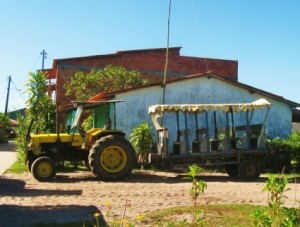
Photo © Michael Sommers.
My sister and I just returned from a 3-week trip along the coast of Bahia. One of the largest states in Brazil, Bahia is about the size of France. Although (sadly) there are no high-speed TGV trains to whisk one around, a surprisingly diverse array of transportation options is available. As we were constantly on the move, working our way up and down the coast – Bahia boasts the longest (932 km/580 miles) and one of the most beautiful coastlines in the country – with the exception of airplanes, we sampled them all:Buses in Brazil link cities and towns of all sizes. They are plentiful, comfortable, and surprisingly punctual. During this trip, we took two types: long-distance expresso buses and local convencional buses.
Expressos, which only hit major towns, are outfitted with plush seats that lean back considerably and complimentary filtered water at the rear (next to the bathroom). The drawback is that they’re air-conditioned, i.e. the windows are hermetically sealed and, in order to counteract the heat emanating from 60 snoozing bodies, the driver proceeds to blast air at glacial temperatures throughout the vehicle. This is why savvy Brazilians travel with caps, hoodies, scarves, thick socks, and even sheets and blankets (yes, even though this is the tropics).
Convencionais are more basic (but still moderately plush) buses that operate on local routes. For better or for worse, they’ll stop wherever a passenger wants (even in the middle of nowhere). For this reason, such buses are nicknamed “pinga pingas” – literally “drop drops” (i.e. of water) – because, like a leaky faucet, they’re constantly dropping and picking up passengers (thus making for a longer voyage). On the upside, convencionais are mercifully not air-conditioned; cooling is provided by good, old-fashioned breezes streaming in through the open windows.
Small and medium-sized towns throughout Brazil, particularly in the Northeast, thrive on motorcycle taxis. In fact, many towns boast entire fleets whose drivers (usually young men) huddle together at designated moto-taxi stands, dressed in brightly colored company t-shirts. If you’re traveling light and solo, there’s nothing like sailing over a red dirt road or along a low-tide beach with the wind in your hair (or smacking against your helmet). Don’t be afraid to hold your driver tightly (this won’t be construed as sexual harassment), especially when navigating the inevitable cobblestones, curves, and quebra molas (speed bumps).
If you’re traveling with lots of luggage and/or lots of people, over long distances and difficult roads, and/or it’s raining, there’s nothing like hailing a cab (you’d be surprised the places they’re willing to take you). In smaller towns, taxis aren’t metered. Instead, drivers will have fixed rates within town limits as well as to specific points such as faraway beaches, natural attractions, and secluded hotels in the middle of nowhere. In some cases, they will have a printed tabela (table) with rates to various destinations (which they won’t voluntarily display). If the distance is far, you’re entitled to negotiate; if you’re skilled, you’ll succeed in knocking a few reais off the fare. In Brazil, a good taxi driver is a valuable asset; if you hit it off with your cabbie, ask for his (or her) card with phone number for future rides.
Known as lanchas (as in “launches”), they are often the only way to get to far-flung beaches as well as islands such as Morro de São Paulo and Boipeba. Scenic, yes. Speedy – not always – but they’re usually much more so than regular cheaper, larger, and slower barcos (boats). Lanchas can also be a little cramped since the operators will have no compunction about filling them up to the gills with passengers. Schedules often change with the tides. It’s best to purchase tickets in advance so you’re not stranded.
On islands such as Morro de São Paulo and Boipeba, there are no cars – only jegues (donkeys) and tractors. Hitched to wagons with wooden benches (see above photo), tratores are the only way to get around the “interiors” of these islands, particularly between isolated fishing villages. Schedules are unheard of – usually a minimum of 4 people is required to incite a tractor driver to undertake a journey; the more passengers hop aboard, the cheaper the ride.
Few things are more idyllic than walking a kilometer or two down a deserted palm-fringed beach – unless, that is, you’re heading to your secluded beachfront hotel, laden down with luggage, and a broiling sun is beating down from above. For this reason, you’ll be happy to fork out a few reais to the muscular, agile, barefoot boys and young men who, armed with carrinhos de mão (wheelbarrows), will effortlessly wheel your luggage along the most slip-siding terrain while you trudge along behind, trying in vain to keep up these fleet-footed Fred Astaires of the sand.